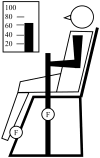High-Speed Cycling Intervention Improves Rate-Dependent Mobility in Older Adults
- PMID: 27501360
- PMCID: PMC5161700
- DOI: 10.1249/MSS.0000000000001069
High-Speed Cycling Intervention Improves Rate-Dependent Mobility in Older Adults
Abstract
Purpose: The aim was to determine the feasibility of a 6-wk speed-based exercise program that could be used to initiate new exercise behaviors and to improve rapid movement in older adults approaching frailty.
Methods: The intervention group included 14 older adults (3 males and 11 females; mean ± SD, age = 70 ± 7.6 yr, height = 1.6 ± 0.11 m, mass = 76.8 ± 12.0 kg, body mass index = 27.7 ± 4.7 kg·m). The control group included 12 older adults (6 males and 6 females; mean ± SD, age = 69.2 ± 6.9 yr, height = 1.7 ± 0.09 m, mass = 78.2 ± 10.9 kg, body mass index = 25.3 ± 2.7 kg·m). Subjects included active older adults, including regular exercisers, but none were engaged in sports or exercises with an emphasis on speed (e.g., cycling spin classes or tennis). Stationary recumbent cycling was selected to minimize fall risk, and low pedaling resistance reduced musculoskeletal and cardiovascular load. Two weekly 30-min exercise sessions consisted of interval training in which subjects pedaled at preferred cadence and performed ten 20-s fast cadence intervals separated by 40 s of active recovery at preferred cadence.
Results: Significant group-time interactions (P < 0.05) supported a 2-s improvement in the timed up and go test and a 34% improvement in rapid isometric knee extension contractions in the exercise group but not in controls. Central neural adaptations are suggested because this lower extremity exercise program also elicited significant improvements in the untrained upper extremities of the exercise group (elbow extension rate of force development scaling factor and Nine-Hole Peg Test, P < 0.05).
Conclusion: These results demonstrate that a relatively low dose of speed-based exercise can improve neuromuscular function and tests of mobility in older adults. Such a program serves as a sensible precursor to subsequent, more vigorous training or as an adjunct to a program where a velocity emphasis is lacking.
Figures


Similar articles
-
Power Training-induced Increases in Muscle Activation during Gait in Old Adults.Med Sci Sports Exerc. 2017 Nov;49(11):2198-2025. doi: 10.1249/MSS.0000000000001345. Med Sci Sports Exerc. 2017. PMID: 28598910 Clinical Trial.
-
The effect of high-intensity cycling training on postural sway during standing under rested and fatigued conditions in healthy young adults.Eur J Appl Physiol. 2016 Oct;116(10):1965-74. doi: 10.1007/s00421-016-3448-1. Epub 2016 Aug 4. Eur J Appl Physiol. 2016. PMID: 27491619 Clinical Trial.
-
All-Extremity Exercise Training Improves Arterial Stiffness in Older Adults.Med Sci Sports Exerc. 2017 Jul;49(7):1404-1411. doi: 10.1249/MSS.0000000000001229. Med Sci Sports Exerc. 2017. PMID: 28166118 Free PMC article. Clinical Trial.
-
Speed endurance training is a powerful stimulus for physiological adaptations and performance improvements of athletes.Scand J Med Sci Sports. 2010 Oct;20 Suppl 2:11-23. doi: 10.1111/j.1600-0838.2010.01193.x. Scand J Med Sci Sports. 2010. PMID: 20840558 Review.
-
On voluntary rhythmic leg movement behaviour and control during pedalling.Acta Physiol (Oxf). 2015 Jun;214 Suppl 702:1-18. doi: 10.1111/apha.12529. Acta Physiol (Oxf). 2015. PMID: 26094819 Review.
Cited by
-
Interlimb Asymmetries Identified Using the Rate of Torque Development in Ballistic Contraction Targeting Submaximal Torques.Front Physiol. 2018 Nov 28;9:1701. doi: 10.3389/fphys.2018.01701. eCollection 2018. Front Physiol. 2018. PMID: 30546321 Free PMC article.
-
Safer cycling in older age (SiFAr): effects of a multi-component cycle training. a randomized controlled trial.BMC Geriatr. 2023 Mar 7;23(1):131. doi: 10.1186/s12877-023-03816-2. BMC Geriatr. 2023. PMID: 36882759 Free PMC article. Clinical Trial.
-
Forced and Voluntary Aerobic Cycling Interventions Improve Walking Capacity in Individuals With Chronic Stroke.Arch Phys Med Rehabil. 2021 Jan;102(1):1-8. doi: 10.1016/j.apmr.2020.08.006. Epub 2020 Sep 9. Arch Phys Med Rehabil. 2021. PMID: 32918907 Free PMC article. Clinical Trial.
-
Upper-Limb Muscle Fatigability in Para-Athletes Quantified as the Rate of Force Development in Rapid Contractions of Submaximal Amplitude.J Funct Morphol Kinesiol. 2024 Jun 20;9(2):108. doi: 10.3390/jfmk9020108. J Funct Morphol Kinesiol. 2024. PMID: 38921644 Free PMC article.
-
The rate of force development scaling factor: a review of underlying factors, assessment methods and potential for practical applications.Eur J Appl Physiol. 2022 Apr;122(4):861-873. doi: 10.1007/s00421-022-04889-4. Epub 2022 Jan 19. Eur J Appl Physiol. 2022. PMID: 35048184 Review.
References
-
- Alberts JL, Linder SM, Penko AL, Lowe MJ, Phillips M. It is not about the bike, it is about the pedaling: forced exercise and Parkinson’s disease. Exerc Sport Sci Rev. 2011;39(4):177–86. Internet. Available from: http://www.ncbi.nlm.nih.gov/pubmed/21799425. - PubMed
-
- Alghadir A, Anwer S, Brismée J-M. The reliability and minimal detectable change of Timed Up and Go test in individuals with grade 1–3 knee osteoarthritis. BMC Musculoskelet Disord [Internet] 2015 Jan; [cited 2016 Jan 8];16:174. Available from: http://www.pubmedcentral.nih.gov/articlerender.fcgi?artid=4520098&tool=p.... - PMC - PubMed
-
- Pescatello LS, editor. American College of Sports Medicine. ACSM’s Guidelines for Exercise Testing and Prescription. Baltimore: Wolters Kluwer | Lippincott Williams & Wilkins; 2016.
-
- Bellumori M, Jaric S, Knight CA. The rate of force development scaling factor (RFD-SF): protocol, reliability, and muscle comparisons. ExpBrain Res. 2011 Jul;212(3):359–69. - PubMed
-
- Bellumori M, Jaric S, Knight CA. Age-related decline in the rate of force development scaling factor. Motor Control. 2013;17:370–81. Internet. Available from: http://www.ncbi.nlm.nih.gov/pubmed/23761421. - PubMed
Publication types
MeSH terms
Grants and funding
LinkOut - more resources
Full Text Sources
Other Literature Sources

